供应链管理详细资料英文版
- 格式:ppt
- 大小:1.28 MB
- 文档页数:25

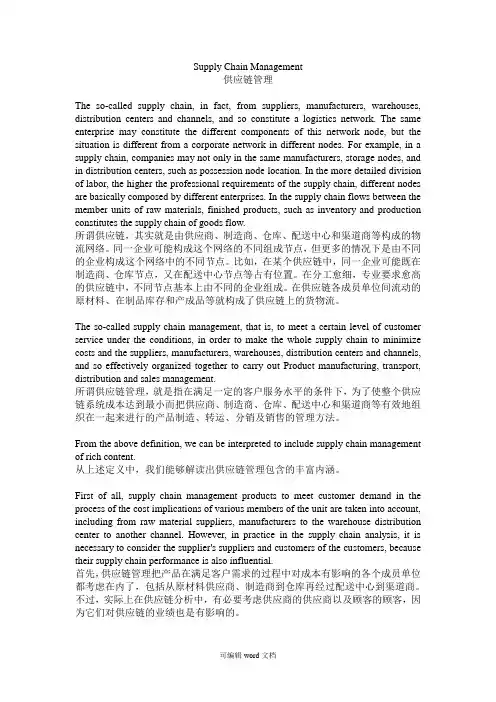
Supply Chain Management供应链管理The so-called supply chain, in fact, from suppliers, manufacturers, warehouses, distribution centers and channels, and so constitute a logistics network. The same enterprise may constitute the different components of this network node, but the situation is different from a corporate network in different nodes. For example, in a supply chain, companies may not only in the same manufacturers, storage nodes, and in distribution centers, such as possession node location. In the more detailed division of labor, the higher the professional requirements of the supply chain, different nodes are basically composed by different enterprises. In the supply chain flows between the member units of raw materials, finished products, such as inventory and production constitutes the supply chain of goods flow.所谓供应链,其实就是由供应商、制造商、仓库、配送中心和渠道商等构成的物流网络。


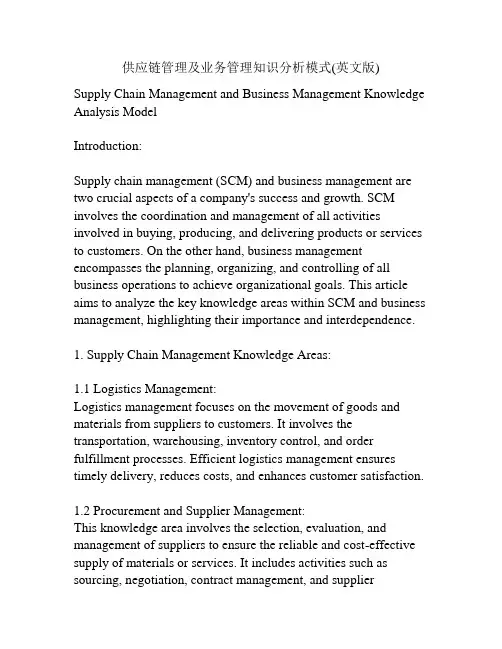
供应链管理及业务管理知识分析模式(英文版) Supply Chain Management and Business Management Knowledge Analysis ModelIntroduction:Supply chain management (SCM) and business management are two crucial aspects of a company's success and growth. SCM involves the coordination and management of all activities involved in buying, producing, and delivering products or services to customers. On the other hand, business management encompasses the planning, organizing, and controlling of all business operations to achieve organizational goals. This article aims to analyze the key knowledge areas within SCM and business management, highlighting their importance and interdependence.1. Supply Chain Management Knowledge Areas:1.1 Logistics Management:Logistics management focuses on the movement of goods and materials from suppliers to customers. It involves the transportation, warehousing, inventory control, and order fulfillment processes. Efficient logistics management ensures timely delivery, reduces costs, and enhances customer satisfaction.1.2 Procurement and Supplier Management:This knowledge area involves the selection, evaluation, and management of suppliers to ensure the reliable and cost-effective supply of materials or services. It includes activities such as sourcing, negotiation, contract management, and supplierperformance measurement.1.3 Demand Planning and Forecasting:Demand planning and forecasting involve the estimation of future customer demand for products or services. It helps in the optimization of inventory levels, production planning, and resource allocation. Accurate forecasting reduces stockouts, minimizes inventory carrying costs, and improves customer service.1.4 Inventory Management:Inventory management encompasses the control and optimization of inventory levels to meet customer demands while minimizing holding costs. It includes inventory classification, safety stock determination, replenishment strategies, and utilization of advanced inventory management techniques like just-in-time (JIT) and economic order quantity (EOQ).1.5 Risk Management:Supply chain risk management involves identifying, assessing, and mitigating risks associated with supply chain operations. It includes evaluating risks related to supplier reliability, demand volatility, transportation disruptions, natural disasters, and geopolitical factors. Effective risk management helps in minimizing potential disruptions and ensuring business continuity.2. Business Management Knowledge Areas:2.1 Strategic Planning:Strategic planning involves setting the long-term goals and direction of the company. It includes analyzing internal andexternal factors, conducting market research, defining the company's mission and vision, and formulating strategies to achieve competitive advantage. Strategic planning provides a roadmap for decision-making and resource allocation.2.2 Financial Management:Financial management focuses on the efficient utilization and allocation of financial resources within the company. It includes budgeting, financial analysis, cash flow management, and capital investment decisions. Effective financial management ensures profitability, liquidity, and sustainability of the business.2.3 Organizational Behavior:Organizational behavior refers to understanding individual and group dynamics within the company. It includes topics like motivation, leadership, communication, team dynamics, and organizational culture. Understanding and managing organizational behavior promotes employee engagement, productivity, and effective teamwork.2.4 Marketing and Sales Management:Marketing and sales management involves the identification of target markets, development of marketing strategies, and implementation of promotional activities to achieve sales objectives. It includes market research, product development, pricing, distribution, and customer relationship management. Effective marketing and sales management drive customer acquisition, retention, and revenue generation.2.5 Operations Management:Operations management focuses on the design, control, and improvement of production processes to deliver products or services efficiently. It includes capacity planning, production scheduling, quality management, and continuous process improvement. Effective operations management increases productivity, reduces costs, and ensures customer satisfaction.Conclusion:Supply chain management and business management are interconnected and essential for the success of any company. A comprehensive knowledge analysis model helps to identify and prioritize key knowledge areas within these domains. Companies that effectively manage their supply chains and employ sound business management principles gain a competitive edge, achieve operational excellence, and sustain long-term growth and profitability.3. Interdependence between Supply Chain Management and Business Management:The interdependence between supply chain management and business management is crucial for the overall success and growth of a company. While supply chain management focuses on the operational aspects of sourcing, production, and delivery, business management provides the strategic framework and direction for these activities. The knowledge areas within both domains are interconnected and rely on each other for effective decision-making and implementation.For example, strategic planning plays a significant role in both supply chain management and business management. A company'sstrategic objectives and goals influence its supply chain strategy, such as sourcing strategies, selection of suppliers, and distribution network design. On the other hand, the company's supply chain capabilities and constraints impact its overall strategic decisions, such as market entry strategies, product differentiation, and pricing.Similarly, financial management is essential for both supply chain management and business management. Efficient financial management helps in allocating resources effectively within the supply chain, such as optimizing inventory levels, implementing cost-saving measures, and improving cash flow. It also enables the company to make informed business decisions, such as investing in new technologies or expanding into new markets.Organizational behavior plays a critical role in both domains as well. Effective communication, teamwork, and leadership within the supply chain contribute to smooth coordination and collaboration among various stakeholders. In business management, understanding organizational behavior helps in creating a positive work culture, motivating employees, and fostering innovation, thereby leading to better business performance and customer satisfaction.Marketing and sales management are interconnected with supply chain management as well. Market research and customer insights are crucial in demand planning and forecasting, which informs supply chain decisions, such as production levels, inventory management, and transportation requirements. Conversely, supply chain capabilities influence marketing and sales strategies, such as product availability, delivery speed, and customer service levels.Integration between these knowledge areas ensures alignment between supply and demand, resulting in customer satisfaction and competitive advantage.Furthermore, operations management plays a key role in both supply chain management and business management. Efficient operations management techniques, such as lean manufacturing, Six Sigma, and total quality management, improve productivity, reduce waste, and enhance product/service quality. These improvements, in turn, enhance the company's overall performance and competitiveness. Additionally, operations management principles help in optimizing supply chain processes, such as production scheduling, inventory management, and order fulfillment, leading to cost savings, shorter lead times, and improved customer satisfaction.4. Importance of Supply Chain Management and Business Management Knowledge:The knowledge areas within supply chain management and business management are crucial for companies to remain competitive, adapt to changing market dynamics, and drive overall business success. Below are the key reasons why companies should prioritize and invest in these knowledge areas:4.1 Optimal Resource Utilization:Efficient supply chain management ensures optimal utilization of resources, such as raw materials, production capacity, and transportation, resulting in cost savings and improved profitability. Likewise, effective business management helps in allocatingfinancial, human, and technological resources to their best possible use, maximizing the value generated by the company.4.2 Enhanced Customer Satisfaction:Supply chain management focuses on meeting customer demands by ensuring the availability of products/services, on-time delivery, and quick response to customer queries. This improves customer satisfaction and loyalty. Business management, meanwhile, helps in developing effective marketing and sales strategies, understanding customer preferences, and delivering superior customer service, further enhancing customer satisfaction and building long-term relationships.4.3 Risk Mitigation and Resilience:Supply chain management knowledge areas, such as risk management and procurement, help in identifying and mitigating potential risks to the supply chain, including disruptions from suppliers, transportation issues, or natural disasters. Business management complements these efforts by implementing suitable risk management strategies at the organizational level, such as diversifying revenue streams, implementing robust financial controls, and building strong relationships with key stakeholders. This ensures business continuity and resilience.4.4 Competitive Advantage:Companies that excel in supply chain management gain a competitive advantage by offering better value to customers through lower costs, higher product quality, and faster delivery. Similarly, effective business management, through strategic planning, marketing, and operations, helps companies differentiatethemselves from competitors and create unique value propositions that attract and retain customers.4.5 Innovation and Agility:Both supply chain management and business management knowledge areas foster innovation and agility within organizations. Supply chain innovation, such as implementing advanced technologies like automation, AI, and IoT, improves operational efficiency, reduces costs, and enables faster response to market changes. Business management knowledge areas, such as strategic planning and organizational behavior, help in creating a culture of innovation, driving continuous improvement, and fostering agile decision-making.Conclusion:Effective supply chain management and business management are critical for the success of any company. The knowledge areas within these domains are interconnected and mutually dependent. Companies that prioritize and invest in these knowledge areas gain a competitive edge, achieve operational excellence, and sustain long-term growth and profitability. Understanding and implementing the key principles and practices within supply chain management and business management enable companies to optimize resources, enhance customer satisfaction, mitigate risks, and leverage opportunities for innovation and competitive advantage.。

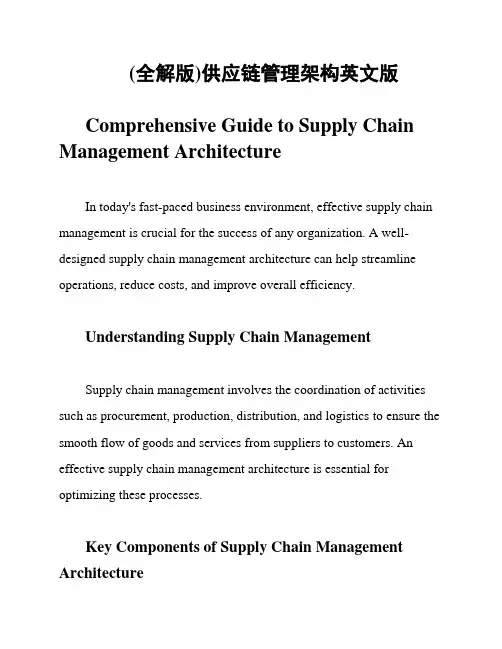
(全解版)供应链管理架构英文版Comprehensive Guide to Supply Chain Management ArchitectureIn today's fast-paced business environment, effective supply chain management is crucial for the success of any organization. A well-designed supply chain management architecture can help streamline operations, reduce costs, and improve overall efficiency.Understanding Supply Chain ManagementSupply chain management involves the coordination of activities such as procurement, production, distribution, and logistics to ensure the smooth flow of goods and services from suppliers to customers. An effective supply chain management architecture is essential for optimizing these processes.Key Components of Supply Chain Management Architecture1. Procurement: This involves sourcing raw materials or products from suppliers. An efficient procurement process is essential for ensuring timely delivery and quality control.2. Production: The production process involves transforming raw materials into finished goods. An effective production architecture should focus on maximizing efficiency and minimizing waste.3. Distribution: Distribution is the process of delivering finished goods to customers. An optimized distribution network can help reduce lead times and improve customer satisfaction.4. Logistics: Logistics involves the planning, coordination, and execution of the movement of goods. A well-designed logistics architecture can help reduce transportation costs and improve delivery times.Benefits of a Well-Structured Supply Chain Management Architecture1. Cost Efficiency: An optimized supply chain management architecture can help reduce costs associated with procurement, production, and distribution.2. Improved Customer Service: By streamlining operations and reducing lead times, a well-structured architecture can improve customer satisfaction.3. Risk Mitigation: Effective supply chain management can help identify and mitigate potential risks such as supply chain disruptions or quality issues.Implementing Supply Chain Management ArchitectureWhen implementing a supply chain management architecture, it is essential to consider factors such as technology, organizational structure, and collaboration with suppliers and partners. Continuous monitoring and optimization are also key to ensuring the success of the architecture.In conclusion, a well-designed supply chain management architecture is essential for the success of any organization. By focusing on key components such as procurement, production, distribution, and logistics, businesses can optimize their operations and achieve cost savings and improved customer satisfaction.。
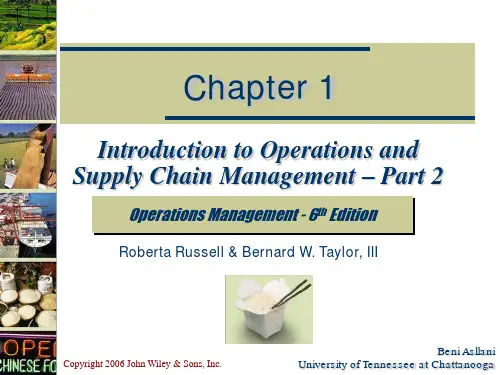
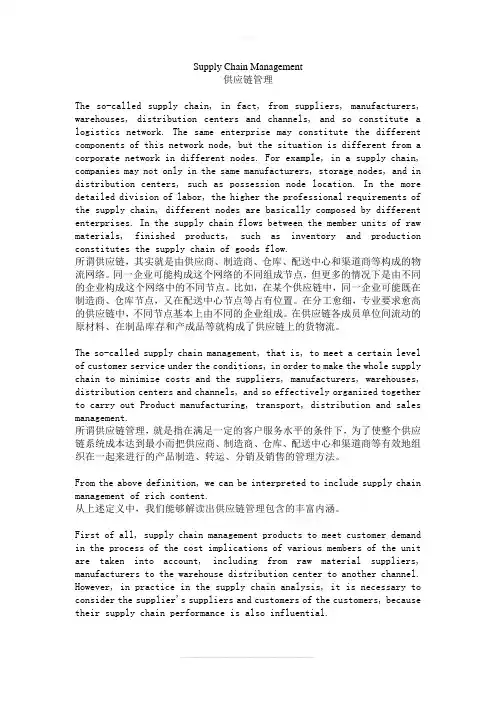
Supply Chain Management供应链管理The so-called supply chain, in fact, from suppliers, manufacturers, warehouses, distribution centers and channels, and so constitute a logistics network. The same enterprise may constitute the different components of this network node, but the situation is different from a corporate network in different nodes. For example, in a supply chain, companies may not only in the same manufacturers, storage nodes, and in distribution centers, such as possession node location. In the more detailed division of labor, the higher the professional requirements of the supply chain, different nodes are basically composed by different enterprises. In the supply chain flows between the member units of raw materials, finished products, such as inventory and production constitutes the supply chain of goods flow.所谓供应链,其实就是由供应商、制造商、仓库、配送中心和渠道商等构成的物流网络。
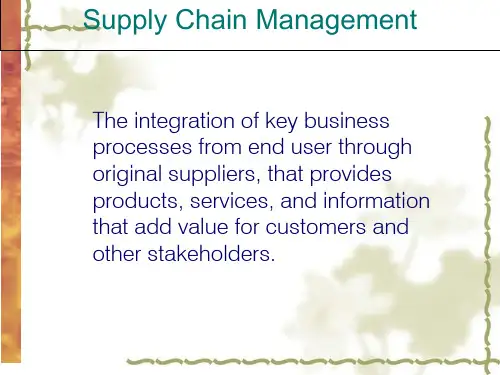

The goal of this case is to get students to understand that the value of centralization of inventory is affected by the coefficient of variation as well as the correlation of demand. High coefficient of variation products with low correlation provide the biggest gains from centralization while low coefficient of variation products with high correlations provide the least value from centralization. The results for this case are obtained using the accompanying spreadsheet Alko Case Study.1.What is the annual inventory and distribution cost of the current distribution system?Status Quo (current distribution system) CalculationsThe worksheet Demand & Costs evaluates the inventory and transportation costs for the status quo where each region is served by a local DC. Each region follows a periodic review policy where an order is placed every 6 days with a replenishment lead time of 5 days. Given a reorder interval of 6 days, the batch size is 6 days of demand. The safety inventory in each location (for each product) is calculated using Equation 12.19. The cycle inventory and safety inventories are evaluated in Cells C43:G48. They are converted into days of demand in Cells K43:O48. It is interesting to get the class to observe that the days of safety inventory held is proportional to the coefficient of variation calculated in Cell C25:G27. The total cost of the status quo is evaluated in Cell H67 to be $960,326.2.What are the savings that would result from following the task force recommendation andsetting up an NDC?We now detail the analysis for the case when all products are stored at a central NDC.Impact of CentralizationThe worksheet Central vs. Local details the inventory and financial impact of centralizing all inventory in an NDC. The mean and standard deviation of centralized demand is obtained in Cells J16:J21 using Equation 12.13. This is used to evaluate the cycle and safety inventory (using Equation 12.19) in CellsJ35:J40. The costs from centralizing each part type is obtained in Cells J56:J58 with the total cost in Cell J59 of $755,164 for the case when demand across all regions is independent. The net savings of $205,162 from centralization are shown in Cell J60.Setting up an NDC reduces annual inventory and distribution costs by $205,162 when demand across regions is independent (has a correlation coefficient of 0).Tables from row 64 to row 114 show the impact of different cycle service levels and correlation coefficient on the net savings from centralization.Observe that as the correlation coefficient increases, the benefit of centralization declines. As the cycle service level increases, the benefit of centralization grows.3.Suggest other options that Gary Fisher should consider.Cells K56:K58 show the marginal savings for each part type. Observe that the marginal savings from part type 1 (low coefficient of variation) are the lowest while the marginal savings from part type 7 (high coefficient of variation) are the highest.This suggests that we should look at options where only some of the products are centralized. This is because centralization requires the building of a new NDC and the size of the new NDC is affected by the parts centralized. Centralizing all parts in an NDC requires an NDC capable of handling about 700K units per year at a cost of about $1.1 million (from Figure 12-8). This translates to a net investment of $850,000 because we save $50,000 per DC that is closed.Centralize only Parts 3 & 7The worksheet Option 1.0 shows all calculations for the case where parts of type 1 are decentralized while parts of type 3 and 7 are centralized at the NDC. Cell H68 shows the total operating cost of such a system to be $765,064 for the case where all demands are independent. This option thus results in a net savings of $195,262.The NDC to be built, however, is now much smaller and requires a smaller investment. The total units shipped through the NDC in this case are 358,759 requiring an NDC investment of only about $650,000. Clearly the return on investment in this case is higher than if all products are centralized.Centralize only Parts 7The worksheet Option 1.0a shows all calculations for the case where parts of type 1 and 3 are decentralized while parts of type 7 are centralized at the NDC. Cell H68 shows the total operating cost of such a system to be $828,921 for the case where all demands are independent. This option thus results in a net savings of $131,405.The NDC to be built, however, is now much smaller and requires a smaller investment. The total units shipped through the NDC in this case are 165,820 requiring an NDC investment of only about $300,000.Centralize Parts 3 & 7 and Combine Regions 4 and 5The worksheet Option 2 shows all calculations for the case where parts of type 1 are decentralized (regions 4 and 5 are combined) while parts of type 3 and 7 are centralized at the NDC. We make the assumption that transportation costs do not change into region 5. Cell H68 shows the total operating cost of such a system to be $751,714 for the case where all demands are independent.This option thus results in a net savings of $208,612.Summary of ResultsThese results are summarized in worksheet Summary for the case where demand across all regions is independent.Any positive correlation will reduce the benefit of centralization.A simple solution is to centralize parts 3 and 7 and decentralize parts 1. A more profitable (though also a bit more complex) solution is to further combine regions 4 and 5 so that part 1 for both regions is held in a single DC. The higher profitability relies on the assumption that transportation costs to regions 4 and 5 will not change on this combination. This assumption would have to be verified before this decision is implemented.。